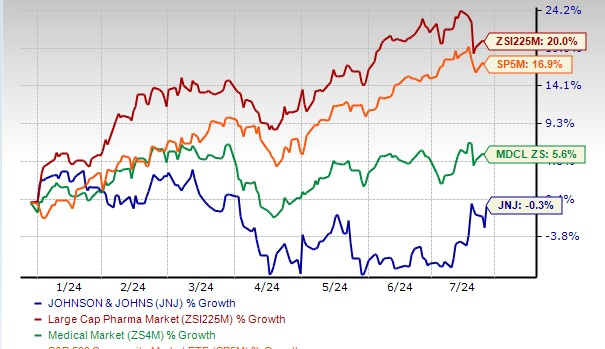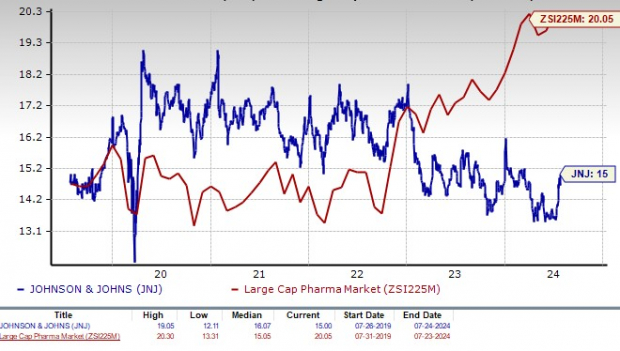On Jul 17, J&J (JNJ) announced strong second-quarter results, beating estimates for both earnings and sales. While the Innovative Medicines segment outperformed expectations, MedTech’s performance was a bit softer than expected due to macroeconomic issues in China, increased competitive pressure and currency headwinds.
Sales of J&J’s Innovative Medicines segment rose 5.5% year over year. Higher sales of key products such as Darzalex, Stelara, Tremfya, Uptravi and Erleada drove the segment’s growth. New drugs like Carvykti, Tecvayli and Spravato also added to the strength. The sales growth was, however, partially dampened by lower sales of Imbruvica, COVID-19 vaccine and generic/biosimilar competition to drugs like Zytiga and Remicade. MedTech segment sales rose 2.2% from the year-ago period.
While J&J maintained its total revenue expectation in the range of $88.0 billion-$88.4 billion, it lowered its previously issued earnings growth expectations for 2024 from a range of $10.57-$10.72 per share to $9.97-$10.07 per share. The company’s expectation of better operational performance was offset by costs associated with recent acquisitions.
As far as expectations from its two segments are concerned, Innovative Medicines segment growth is expected to decelerate in the second half, while MedTech growth is expected to accelerate. However, J&J’s MedTech growth expectations for 2024 were slightly lower than the company’s previous guidance.
Nonetheless, a single quarter’s results are not so important for long-term investors, and the focus should, rather, be on the company’s strong fundamentals. Let’s understand the company’s strengths and weaknesses to better analyze how to play J&J’s stock in the post-earnings scenario.
The Most Diversified Drug Maker
J&J’s biggest strength is its diversified business model. In August 2023, J&J separated its Consumer Health business into a newly listed company called Kenvue (KVUE) , which now operates as a separate and fully independent company. In mid-2024, J&J exited its remaining 9.5% stake in Kenvue’s common stock, bringing the separation to a close.
J&J has more than 275 subsidiaries, which clearly means that the business is extremely well-diversified. Its diversification helps it to withstand economic cycles more effectively. J&J has 26 platforms with more than $1 billion in annual sales. It also has one of the largest R&D budgets among pharma companies.
Innovative Medicines Unit Showing Consistent Strength
J&J’s Innovative Medicine (previously Pharmaceuticals) unit is performing at above-market levels. Its growth is being driven by existing products like Darzalex, Stelara, Tremfya, Uptraviand Erleada and also continued uptake of new launches, including Spravato, Carvykti and Tecvayli.
J&J has a goal of growing the Innovative Medicines unit into a $60 billion ($57 billion on a constant-currency basis) segment by 2025. The segment’s sales rose 6.8% in 2022, 9% in 2023 and 5.3% in the first half of 2024 on an organic basis. In 2024, J&J expects to record above-market growth in the Innovative Medicine unit for the 13th consecutive year. J&J expects the Innovative Medicine business to grow 5% to 7% from 2025 to 2030.
Moreover, J&J believes 10 of its new Innovative Medicine products have the potential to deliver peak non-risk adjusted operational sales of $5 billion, including new cancer drugs like Talvey and Tecvayli and pipeline candidates like nipocalimab and JNJ-2113.
Sound Cash Position
J&J has sufficient funds to pursue bolt-on acquisitions and deals to boost its portfolio. J&J spent $17 billion on M&A deals in the first half of 2024. The company is also returning value to shareholders through share buybacks and dividend payments. It has hiked its dividends for 62 consecutive years. Its current dividend yield of around 3.4% is attractive.
J&J’s Legal and Other Troubles
J&J faces a slew of lawsuits, which allege personal injuries to patients caused by the use of its medicines, mainly its talc products. J&J faces more than 60,000 lawsuits for its talc-based products. The lawsuits allege that its talc products contain asbestos, which caused many women to develop ovarian cancer.
J&J’s subsidiary, LTL Management, which was established to manage claims in the cosmetic talc litigation, filed for voluntary bankruptcy twice to equitably resolve all present and future talc-related claims. However, both bankruptcy filings were rejected by courts, stating that J&J was not in enough financial stress to qualify for bankruptcy. In May 2024, LTL Management proposed a new plan committing to pay claimants a present value of approximately $6.5 billion or $8 billion nominally over 25 years, which could resolve 99.75% of all pending talc lawsuits against the company.
J&J will also face the patent expiration of the blockbuster drug Stelara in 2025. Stelara generated sales of $5.3 billion in the first half of 2024. The launch of generics could significantly erode the drug’s sales and hurt J&J’s sales and profits. The company said that in Europe, a biosimilar is expected to be launched by the end of July.
Valuation, Estimates and Price
So far this year, J&J’s stock has declined 0.3% against an increase of 20.0% for the industry. The stock has also underperformed the sector as well as the S&P 500. J&J’s stock has also been trading below its 200-day and 50-day moving averages since mid-July.
JNJ Stock Underperforms Industry, Sector & S&P 500
 Zacks Investment ResearchImage Source: Zacks Investment Research
Zacks Investment ResearchImage Source: Zacks Investment Research
From a valuation standpoint, J&J appears attractive relative to the industry and is trading below its 5-year mean. Going by the price/earnings ratio, the company shares currently trade at 15.0 forward earnings, lower than 20.05 for the industry and the stock’s mean of 16.07.
JNJ Stock Valuation
 Zacks Investment ResearchImage Source: Zacks Investment Research
Zacks Investment ResearchImage Source: Zacks Investment Research
Following the earnings guidance cut due to costs related to recent acquisitions, the Zacks Consensus Estimates for 2024 as well as 2025 have gone down, as seen in the chart below.
JNJ Estimate Movement
 Zacks Investment ResearchImage Source: Zacks Investment Research
Zacks Investment ResearchImage Source: Zacks Investment Research
Conclusion
J&J’s Innovative Medicines segment is showing a growth trend and the same is likely to continue in the years ahead. The company has an interesting R&D pipeline that can generate innovative products and drive its growth further.
The cut in the earnings guidance does not concern us much as it was only for costs incurred due to recent acquisitions like that of Shockwave Medical, which will eventually boost the company’s long-term growth.
However, the softness in the MedTech unit, seen in the second quarter, is a concern. It remains to be seen if the trends improve in the second half. The company is likely to continue to incur billions of dollars for legal expenses in future quarters due to its pending lawsuits.
We suggest a new investor should avoid buying this Zacks Rank #4 (Sell) stock right now due to uncertainty surrounding its legal battles.
There are several other large drugmakers that are generating better growth than J&J and make decent investment options. An investor interested in buying a large drugmaker may consider investing in Moderna (MRNA) instead, which has a Zacks Rank #2 (Buy). You can see the complete list of today’s Zacks #1 Rank (Strong Buy) stocks here.
— Kinjel Shah
Want the latest recommendations from Zacks Investment Research? [sponsor]Today, you can download 7 Best Stocks for the Next 30 Days. Click to get this free report.
Source: Zacks

